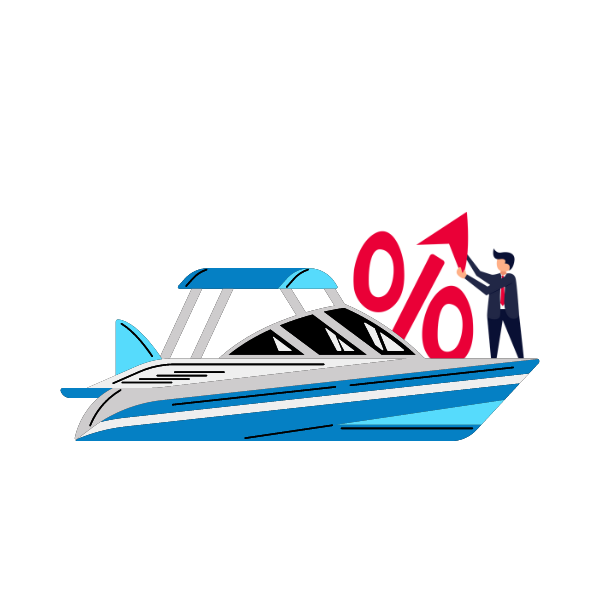Imagine. You. Your brand-new boat. International waters. Lots and lots of cruising around. Instantly puts a smile on your face, right? A villain that may enter the scene and turn that smile into a frown is, none other than, tax! That is why you should know how to avoid VAT on boats.
Doesn’t matter if it’s a luxury RIB, a motorboat, or a sailing yacht. The choice to purchase a new boat is always thrilling. However, it’s crucial to understand any potential tax implications of the purchase or transfer.
Boats are a “movable” asset, you noticed that without a doubt. Because of that, the tax rules can be challenging; they frequently vary between nations. Brexit has further added to the complexity.
The two main areas of problem will frequently be VAT and Customs Duty. Some owners have already unintentionally charged their boats twice as much VAT. They might do so while transporting boats between the UK and the EU.
It’s crucial for the owner to have a plan in place for handling any tax concerns when purchasing a boat. The VAT duty analysis requires consideration of a certain variety of factors. They range from the location of the boat to the buyer’s place of residence. And whether you sell the boat through a margin scheme or whether you purchase through a business.
What is VAT on boats?
The EU created the Value Added Tax (VAT), a type of tax. Each member state’s government imposes it as a tax on consumption. VAT is due on boats you bring into EU and on boats that EU citizens buy and use inside EU. There is a possibility of allowing an owner to operate a boat in the EU without being liable for VAT. Moreover, VAT also applies to vessels, which spend over six months sailing in the EU in any calendar year.
Proof of VAT Payment
The ideal form of proof is simple. It’s the original VAT invoice from when you originally bought the boat within the EU or when you imported it from outside EU. Invoices for the materials used in the boat’s construction will do with vessels that were made at home.

If older ships from before 1985 were in EU on December 31, 1992, authorities consider them having paid their VAT. But there must be documentation to prove both dates. A marine survey, Part 1 registration, insurance documentation, or a builder’s certificate might serve as proof of age. Similarly, invoices for mooring or winter storage would prove location.
For vessels that are to stay in the UK, it is advised that you carry a Bill of Sale (if applicable, between two private individuals in the UK) while cruising within the EU, if you cannot present the usual documentation as above. Although this does not prove beyond a reasonable doubt that you paid VAT, it shows that UK authorities oversee determining the tax status.
Boats Transported Between the UK And EU
Following Brexit, the UK and EU have not fully “joined-up” their different VAT rules for recreational boats. Owners should be aware of this. They shouldn’t assume just because they have paid VAT in one territory, they will not also have to pay VAT in another territory in the future.
You should not assess local VAT when new boats are purchased in the UK or the EU and subsequently permanently exported. You will incur import VAT (and perhaps duty) in the country of destination.
The rules can get a little complicated in some cases. Like when you temporarily relocate boats with UK addresses into the EU or vice versa for a season, holiday, repair, etc.
How to Avoid VAT on Boats in the UK?
Tax officials throughout the world are tightening their grasp on our wallets. It’s critical to comprehend how to sell a boat with the dreaded “VAT not paid” status.
Let’s dispel one major myth: VAT is always due on all boats travelling through European seas.
No! Only if the boat’s owner resides in the EU, then is the VAT due. The prestige of the owner, not the status of the vessel, is crucial. You can become a tax resident in most EU nations by residing ashore for 183 days out of the year. In some nations, regardless of how much time you spend there, the tax authorities will consider you a resident if you possess a holiday house there.
Most EU nations will let you purchase a vessel without paying VAT if you export yourself along with the vessel within a set timeframe, often 90 to 180 days following delivery. If you’re planning to go round, the globe or cross the Atlantic outside of Europe, for example, this is the ideal approach to avoid paying VAT on a new vessel. When you get back to Europe, the issue materialises. Therefore, this clarifies how to avoid VAT on boats.
The Strategies
There are several ways to prevent or lessen the effects of this:
- Avoid travelling to the EU for more than six months. The EU does not encompass all of Europe. There are, in fact, some areas of the EU that do not belong to the EU Customs Union. Gibraltar is the most practical of these for travelers entering or departing the Mediterranean.
- Pay the VAT but do it in a nation where the rate is low—it ranges from 5.4% in Malta to 25% in Sweden. Payment will be based on the boat’s depreciated value, not its current worth.
- Create a business with a Gibraltar address to own the vessel. You can then rent or lease back that from the firm for a little fee. Due to significant annual legal expenditures associated with maintaining the corporation structure, this option is only practical for high-value boats.

VAT on Boats for Second-Hand buyers and Cases of Exemption
Before claiming that a boat has its VAT paid, the Association of Brokers and Yacht Agents (ABYA) advises that its members collect the necessary documentation from the vendor. Sadly, not everyone is as careful, which might cause delays in a transaction down the road. On the other hand, there are brokers who can easily find a long-forgotten paper trail, even in cases where the companies involved are no longer in operation.
Furthermore, the possibility of a VAT-paid boat losing this status complicates matters. This will occur, for example, if you sell it outside the EU, even if both the buyer and the seller are EU citizens. It is important to understand how to avoid VAT on boats.
Conditions for Exemption
However, it can be eligible for VAT exemption if the permanent importation of the boat also involves moving your residency from outside the EU. Like this, a boat that has paid VAT and has been exported from the EU (for example, during long-term cruising) may also be eligible for exemption upon return. The conditions include:
- You bring the boat back into the EU within three years after export.
- If it was brought into the country by the same person who brought it out of the EU and has not undergone any significant repairs that have raised its worth.
If you don’t live in an EU country, you can also temporarily import the ship without paying VAT, for example, to go on a cruise around the EU. One that can last for up to 18 months. Now, you have a clear understanding of how to avoid VAT on boats.
Buying Without the Correct Documentation
If a used boat lacks the necessary documentation, should you anticipate a price reduction? There isn’t a simple solution to this. The condition and degree of equipment of the vessel has a significantly higher impact on the value of many smaller, lower-value ships than the 20% VAT. On the other hand, if the paperwork is missing, it is obvious that a one-owner boat that is only a few years old will have its value lowered by the whole amount of the VAT.
VAT on boats is a tax on a transaction—the sale or importation of goods or services. Not on the vessel itself. Hence, there are sadly many situations in which the legal status is not that clear. A knowledgeable broker or attorney can be of great assistance in these situations, especially for high-value boats.
What Special Situations Will Exempt You From Paying Boat VAT Again?
It is obvious that a boat will be liable to VAT upon its return if you export it from the UK or the EU for longer than three years. Even if it is returned by the same owner to the same country as it departed, you cannot avoid VAT. But there can be exceptions.
It appears that if you complete a circumnavigation that lasts longer than three years, you will be subject to VAT upon return! However, the following are some unusual circumstances that allow exemptions. Thus, you can learn how to avoid VAT on boats.
The Special Circumstances
When the Brexit transition period came to an end, Her Majesty’s Revenue and Customs (HMRC) made an initial declaration. According to which, owners of boats that had been in the UK under current ownership and were in the EU might avoid incurring a second VAT payment. This could be the case if the vessel returned to the UK by 30 June 2022.
Regardless of when the boat departed the UK, this was applicable. The UK government repealed the three-year requirement for returned goods relief for recreational boats on January 1, 2022.
Therefore, vessels that sail back to the UK won’t have to pay VAT again. It only applies to boats that have been based in the UK while they have been owned by their present owner. As well as two boats that are a UK resident’s personal property and are on their way back to the country for personal use.
All boats that you purchase, keep, and currently own in the EU but have never been in the UK are still subject to UK VAT. Hence, you should remain aware of how to avoid VAT on boats.
Conclusion:
Overall, the VAT story may sound complex but once you find the perfect channels of passage for your boat in the sea of legalities, you can avoid as many icebergs of VAT as you wish. It takes a little of research and a proper commitment to maintaining the paperwork.


